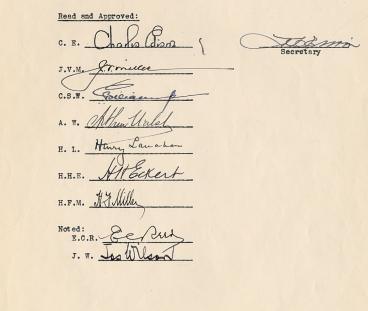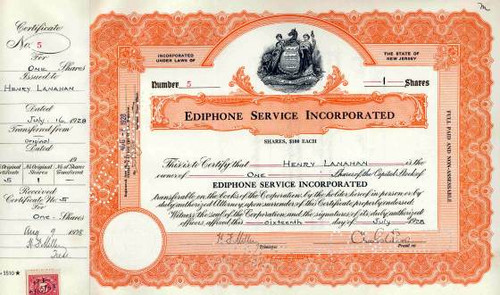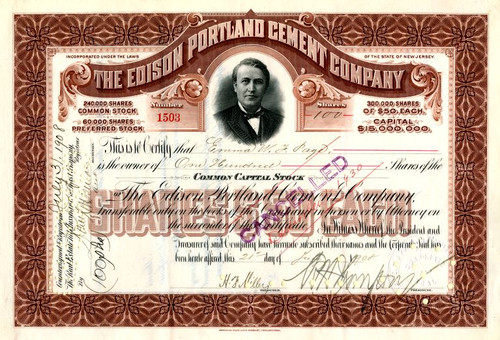Historic Board of Director Minutes of Board meeting from the Thomas A. Edison Industries. Signatures include Charles Edison, J.V. Miller, C.S. Williams Jr., A. Walsh, Henry Lanahan, H.H. Eckert, H. F. Miller and F. C. Erwin. This five page document is over 73 years old. Thomas A. Edison Industries was the parent company of all the Edison Enterprises. The minutes discuss a number of operating issues from Edison - Splitdorf, Emark, Primary Battery, Ediphone, Storage Battery, Edicraft, and Edison Electrical Controls.

Signatures on last page of Minutes
Charles Edison was born at Glenmont on August 3, 1890 at Glenmont. Charles graduated from the Hotchkiss School in Lakeville, Connecticut. He married his college sweetheart, Carolyn Hawkins, at his parents' winter home in Fort Myers, Florida, March 27, 1918. He became president of his father's company, Thomas A. Edison, Incorporated, in 1927. He ran the company until it was sold in 1959. Charles is the best known of the Edison children because of his second career, in public service. In the mid-1930s he served in the cabinet of President Franklin Roosevelt--first as Assistant Secretary of the Navy, then as Acting Secretary. New Jersey voters elected him as their governor in 1940, but Charles broke a family tradition in the process--he ran as a Democrat. He proposed an updated state constitution for the state, but voters rejected it in a statewide referendum. However, his work inspired later New Jersey legislators to pass a modern constitution after Edison's governorship. He also founded a charitable foundation that now bears his name, the Charles Edison Fund. He died on July 31, 1969 only a few weeks after man first landed on the moon. Thomas A. Edison History One of the outstanding geniuses in the history of technology, Thomas Edison earned patents for more than a thousand inventions, including the incandescent electric lamp, the phonograph, the carbon telephone transmitter, and the motion-picture projector. In addition, he created the world's first industrial research laboratory. Born in Milan, Ohio, Edison was an inquisitive child. By the time he was 10 he had set up a small chemical laboratory in the cellar of his home after his mother had aroused his interest in an elementary physical science book. He found the study of chemistry and the production of electrical current from voltaic jars especially absorbing and soon operated a homemade telegraph set. In 1868 he obtained a position in Boston as an expert night operator for Western Union Telegraph Company; by day he slept little, however, for he was gripped by a passion for manipulating electrical currents in new ways. Borrowing a small sum from an acquaintance, he gave up his job in the autumn of 1868 and became a free-lance inventor, taking out his first patent for an electrical vote recorder. In the summer of 1869 he was in New York, sleeping in a basement below Wall Street. At a moment of crisis on the Gold Exchange caused by the breakdown of the office's new telegraphic gold-price indicator, Edison was called in to try to repair the instrument; this he did so expertly that he was given a job as its supervisor. Soon he had remodeled the erratic machine so well that its owners, the Western Union Telegraph Company, commissioned him to improve the crude stock ticker just coming into use. The result was the Edison Universal Stock Printer, which, together with several other derivatives of the Morse telegraph, brought him a sudden fortune of $40,000. With this capital he set himself up as a manufacturer in Newark, New Jersey, producing stock tickers and high-speed printing telegraphs. In 1876 Edison gave up the Newark factory altogether and moved to the village of Menlo Park, New Jersey, to set up a laboratory where he could devote his full attention to invention. He promised that he would turn out a minor invention every ten days and a big invention every six months. He also proposed to make inventions to order. Before long he had 40 different projects going at the same time and was applying for as many as 400 patents a year. In September 1878, after having viewed an exhibition of a series of eight glaring 500-candlepower arc lights, Edison boldly announced he would invent a safe, mild, and inexpensive electric light that would replace the gaslight in millions of homes; moreover, he would accomplish this by an entirely different method of current distribution from that used for arc lights. To back the lamp effort, some of New York's leading financial figures joined with Edison in October 1878 to form the Edison Electric Light Company, the predecessor of today's General Electric Company. On October 21,1879, Edison demonstrated the carbon-filament lamp, supplied with current by his special high-voltage dynamos. The pilot light-and-power station at Menlo Park glowed with a circuit of 30 lamps, each of which could be turned on or off without affecting the rest. Three years later, the Pearl Street central power station in downtown New York City was completed, initiating the electrical illumination of the cities of the world. In 1887 Edison moved his workshop from Menlo Park to West Orange, New Jersey, where he built the Edison Laboratory (now a national monument), a facility 10 times larger than the earlier one. In time it was surrounded with factories employing some 5,000 persons and producing a variety of new products, among them his improved phonograph using wax records, the mimeograph, fluoroscope, alkaline storage battery, dictating machine, and motion-picture cameras and projectors. During World War I, the aged inventor headed the Naval Consulting Board and directed research in torpedo mechanisms and antisubmarine devices. It was largely owing to his urging that Congress established the Naval Research Laboratory, the first institution for military research, in 1920. Throughout his career, Edison consciously directed his studies to devices that could satisfy real needs and come into popular use. Indeed, it may be said that in applying himself to technology, he was fulfilling the ideals of democracy, for he centered his attention upon projects that would increase the convenience and pleasure of mankind. Below is history of Thomas Alva Edison Companies: Prolific inventor Thomas Alva Edison (1847-1931) has had a profound impact on modern life. In his lifetime, the "Wizard of Menlo Park" patented 1,093 inventions, including the phonograph, the kinetograph (a motion picture camera), and the kinetoscope (a motion picture viewer). Edison managed to become not only a renowned inventor, but also a prominent manufacturer and businessman through the merchandising of his inventions. 1847 Thomas Alva Edison born on February 11 in Milan, Ohio. 1854 Edison's family moves to Port Huron, Michigan. 1859 Edison takes job selling newspapers and candy on the Grand Trunk Railway. 1862 Edison begins work as a telegraph operator in Port Huron. 1863 Edison obtains telegraph job for the Grand Trunk Railway in Ontario. Edison returns to the U.S. in the fall and goes from city to city as a telegraph operator. 1869 Edison arrives in New York City and eventually gets job at Laws' Gold Indicator Co. after fixing the company's stock ticker. Edison receives patent in June for his first invention, an electric vote recorder. Thomas Edison, 1878 1870 Edison opens his first workshop in Newark, New Jersey. 1871 Edison marries Mary Stilwell on December 25. 1873 Edison's daughter, Marion Estelle ("Dot"), is born. 1876 Edison moves to Menlo Park, New Jersey, and establishes laboratory. Edison's son, Thomas Alva, Jr. ("Dash"), is born on January 10. 1877 Edison invents carbon telephone transmitter, extending the clarity and range of the telephone. Edison develops tin foil cylinder phonograph; files patent for it on December 24 which is awarded on February 19, 1878. 1878 Edison Speaking Phonograph Co. incorporated April 24. Edison's son, William Leslie, is born on October 26. 1878-79 Edison devises an electric incandescent light bulb that lasts for more than 13 hours. 1879 Organizes the Edison Ore Milling Company. 1880 Edison discovers phenomenon which is later termed the "Edison Effect". 1881 Edison creates the Edison Electric Lamp Co., the Edison Machine Works and other companies to produce his electric lighting system. 1882 Edison opens a commercial electric station in New York City with approximately 85 customers. The Menlo Park laboratory is closed, and another instituted in New York City. 1884 Edison's wife, Mary, dies on August 9. 1886 Patent awarded to Chichester A. Bell and Charles Sumner Tainter for their wax cylinder graphophone; Edison later refuses to collaborate with them on the invention. Edison marries Mina Miller on February 24. Edison's second wife, Mina, from The Life and Inventions of Thomas Alva Edison , by W. K. L. Dickson and Antonia Dickson, p. 349. Moves his laboratory to East Newark, New Jersey. 1887 Edison develops the New Phonograph, using a wax cylinder. Edison Phonograph Co. formed in October. Edison moves to a larger and more modern laboratory in West Orange, New Jersey. 1888 Edison meets Eadweard Muybridge, who shows him his zoopraxiscope; Edison sets William K. L. Dickson and other assistants to work to make a Kinetoscope, "an instrument which does for the Eye what the phonograph does for the Ear". Improved Phonograph introduced, followed by the Perfected Phonograph. Edison's daughter, Madeleine, is born on May 31. Jesse H. Lippincott assumes control of phonograph companies by forming the North American Phonograph Co. on July 14; leases phonographs as dictation machines. Edison files his first caveat(a Patent Office document in which one declares his work on a particular invention in anticipation of filing a patent application) on the Kinetoscope and Kinetograph on October 8; William Kennedy Laurie Dickson assigned to work on project. 1889 Edison produces dolls with tiny cylinders inside to make them talk for the Edison Phonograph Toy Manufacturing Co.; project ceases in March 1891. Edison General Electric formed in April. Edison Manufacturing Co. is organized. 1890 Lippincott becomes ill and loses control of North American Phonograph Co. to Edison, its principal creditor. Edison's son, Charles, is born on August 3. 1891 A peep-hole viewing machine shown by Edison on May 20 to participants from the National Federation of Women's Clubs. 1892 Thomas A. Edison with his children Madeleine and Charles, circa 1892, from The Life and Inventions of Thomas Alva Edison, by W. K. L. Dickson and Antonia Dickson, p. 352. Edison General Electric and Thomson-Houston merge into General Electric. 1893 Construction on a film studio known to Edison employees as the "Black Maria" completed in February; earliest Edison motion pictures were filmed there. First public demonstration of Edison's 1 1/2" system of Kinetoscope at the Brooklyn Institute on May 9. Copyright registered to William K. L. Dickson for sample kinetoscope records on October 6. 1894 Edison declares bankruptcy for the North American Phonograph Co. Applications submitted to U.S. Patent Office for the Kinetograph and the Kinetoscope. First Kinetoscope parlor opened in midtown Manhattan on April 14. Edison puts the Edison Manufacturing Co. in charge of the manufacture and sale of Kinetoscopes and films on April 1. 1894-95 Edison and Dickson experiment to synchronize sound with film; the Kinetophone is invented which loosely synchronizes a Kinetoscope image with a cylinder phonograph. 1895 The Edison Spring Motor Phonograph appears. Dickson leaves Edison's employ on April 2. C. Francis Jenkins and Thomas Armat demonstrate their Phantoscope, a motion picture projector, in Atlanta, Georgia, in late September to early October. 1896 Edison forms the National Phonograph Co. with the purpose of manufacturing phongraphs for home use on January 27. Spring Motor Phonograph is released under aegis of the National Phonograph Co., followed by the Edison Home Phonograph. Edison negotiates in January with Raff & Gammon to manufacture the Phantoscope which Armat presents as his own invention; machine is renamed the Vitascope in February, and Edison's name put on it. Vitascope publicly exhibited at Koster & Bial's Music Hall on April 23 to great acclaim. The company begins practice of copyrighting its films on October 23 by sending short pieces of positive nitrate film from the motion pictures to the Library of Congress. Edison distances himself from agreement with Raff & Gammon; introduces the Projecting Kinetoscope or Projectoscope on November 30 in Harrisburg, Pennsylvania. 1897 Edison Standard Phonograph manufactured. Edison begins to send positive paper prints of motion pictures for copyright deposit to the Library of Congress in August. James White hired to head Kinetograph Department at the Edison Manufacturing Co. in October. Edison begins legal battles in December that continue for the following year against other producers and exhibitors whom he charges with infringement. 1898 Spanish-American War occurs; Edison Company sends cameraman to Cuba to film scenes of war. Edison's son, Theodore Miller, is born on July 10. 1899 Glenmont, Edison's home, circa 1892, from The Life and Inventions of Thomas Alva Edison, by W. K. L. Dickson and Antonia Dickson, p. 340. Edison Concert Phonograph introduced. 1900 Edison Manufacturing Co. incorporated on May 5. Edwin S. Porter hired by Edison Co. in November to work with film equipment; he later becomes the company's most famous director. 1901 Process for mass-producing duplicate wax cylinders put into effect; they are known as Gold Moulded cylinders. A new film studio for the Edison Co. in New York is completed in January; this is the nation's first indoor, glass-enclosed studio. U.S. Circuit Court recognizes Edison's motion picture patent claims in his suit in July; American Mutoscope & Biograph Company appeals decision. Edison cameras are present at Pan-American Exposition when President McKinley is shot by an assassin. 1902 Circuit Court's decision reversed on March 10 by Court of Appeals, which essentially disallows Edison having a monopoly on motion picture apparatus. 1903 One of the most famous early films, The Great Train Robbery, directed by Edwin S. Porter, is filmed during November. 1905 Business Phonograph introduced. Nickelodeons become popular in Chicago and later spread to other urban areas. 1908 Amberol Record introduced; the cylinder could play as long as four minutes, twice as long as previous cylinders. Association of Edison Licensees and Film Service Association formed; Motion Picture Patents Co. formed from it later to include Biograph licensees. New Edison film studio opened in the Bronx, New York, June-July. 1909 Edwin S. Porter fired on November 10. 1910 Company reorganized into Thomas A. Edison, Inc. 1911 Edison Disc Phonograph shown in public for the first time. 1912 Edison Disc Phonograph put on sale. Blue Amberol introduced, an unbreakable cylinder with superior sound. 1913 Kinetophone is introduced, which attempts to synchronize motion pictures with a phonograph cylinder record. 1915 Kinetophone abandoned. Tone tests for Diamond Discs introduced. Motion Picture Patents Co. found guilty of antitrust violation on October 1. Edison named head of the Naval Consulting Board. 1917 American involvement in World War I begins; Edison creates Army and Navy Model of the Disc Phonograph. 1918 Motion picture studio ceases production in February; studio sold on March 30 to the Lincoln & Parker Film Co. 1926 Edison resigns as president of Thomas A. Edison, Inc., and becomes chairman of the board; his son, Charles takes over as president. 1928 Edison takes over Aplitdorf-Bethlehem Electrical Co., a move which allows him to manufacture radios. Edison awarded Congressional gold metal for his many contributions. 1929 Edison makes programs for radio on long-playing discs; first used by radio station WAAM of Newark, New Jersey, on April 4. Edison Portable Disc Phonograph with New Edison Needle Records introduced. Orders given on October 21 to close the Edison disc business. 1931 Edison dies in West Orange on October 18.








